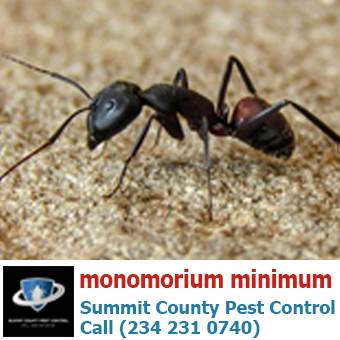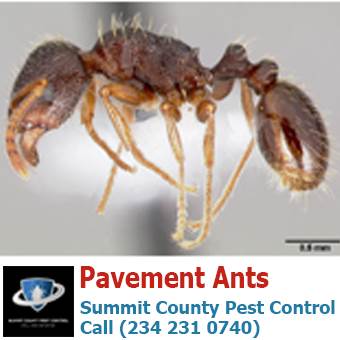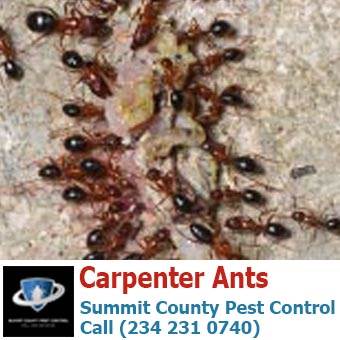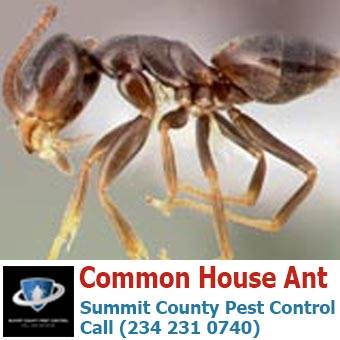Red Fire Ants

These ants are the recent invaders of Ohio, and they are polymorphic which means they vary in size from 1.5-4 mm. Can be found as far north of Ohio. The males are completely black, while the queens and the workers contain a shiny red head and thorax. Their nests or mound are large and dome-shaped with weather-resistant, hard crusts.
They are located in sandy soil, and heavy clay soil. Their mounds are constructed in areas that are exposed and open to the sun, and are found in pastures, under sidewalks, in walls, roadways, and concrete slabs, around junction boxes, heat pumps and traffic lights (they chew on electrical wiring and can cause electrical fires).
Their queens produce 1600 eggs per day. These ants feed on dead and living animals and plants, fruits, shoots and seedlings. They damage developing fruit or flower buds, and plants by feeding on germinating seeds. Calves, cows and horses can be stung in the field. These insects get their name from their power to inflict painful bites and stings which causes a burning sensation.
Little black ants/ monomorium minimum

These dark brown or (jet) black ants are small, about one-eighth of an inch in length and they usually live outside in urban and industrial surroundings in the United States. These ants have a small stinger that is too small to be effective.
They are found throughout most of Ohio. When invading they may form an obvious trail which can easily be followed. These ants are omnivorous meaning they eat everything from seeds, sweets, dead and grease insects or meat.
They search for their food in scent-marked trails. If they get in a building, house or factory the populations occupy cracks and crevices, this can be seen on the walls as trails. These ants build their nests in dark moist areas like under rotting trees, rocks, in open lawns or cement cracks. Inside a building or house they can build their nests under carpeting, in woodworks, baseboards or wall voids.
Pavement Ants

Are dark brown/black and they are about 2.5-4mm long. They also have lines on the head and thorax. These ants feed similar to the black ants on a wide variety of food, especially sweets like sugar, nectar, syrup, honey and fruits. Almost any type of food that reaches the ground will be consumed. They also collect and store dead insects, and small seeds in their nests.
They should be avoided because they contaminate food. Winged productive ants usually move in the spring, but leave when the area where they have a nest gets to warm. So it is nothing new to see them form a swarm in the late fall and into February. When the ants are done mating, the queens make a hole in the soil to lay their eggs.
Usually they house under sidewalks, large rocks, pavement slabs, under floors or building slabs. These ants enter a building through crevices and cracks in interior slabs and walls. Sometimes the remains of excavated nests can be visible as soil particles or sand piles near cracks of concrete slabs.
Carpenter Ants

The average carpenter ant is between 6-13 mm, and doesn’t eat but excavate wood. They are often mistaken for termites, because they both excavate wood. These ants are found in woods that are damp or wet, because they need water to survive, and are known for destroying wood and usually nest outside. They are inside usually found in and are usually active during the spring and the summer, and invade your home in search of food.
During late winter or early spring they are usually active with infestation. They are outside usually active during late spring and early summer and can be seen on tree trunks or sidewalks and build their in tree stumps or landscaping. These ants feed on foods containing fat and sugar and meat. Their nests are made in hollow areas of walls or ceilings. These colonies are usually 100 yards away from their nests.
Odorous House Ants

They are fast and tiny (only 1/8 inch long), and can be found in kitchens especially after heavy rain. Some of them have wings, and they will swarm to breed. These ants feed on many items that are in your home (like dead insects, pastries), but mostly items that contain lots of sugar, outside they feed on nectar and honeydew. They are 2.4- 3 mm long, their body is uniform in color from brown to black.
When they are crushed they have a rotten smell. They can nest everywhere, but especially in a wet and warm place like voids, near heaters, in nests of birds or mammals, window frames, under stacks of fired wood, and termite-damaged wood. Like the black small ants they contaminate food and should be avoided. They are usually in nests but when disturbed they run erratically. Especially in summer they tend to move home about every three weeks.
If your home or office is being overrun by ants, call us today for an appointment as soon as possible. We are the foremost ant control specialists in the entire county.
source https://summitcountypestcontrol.com/blog/five-most-common-ants-in-ohio.html

These ants are the recent invaders of Ohio, and they are polymorphic which means they vary in size from 1.5-4 mm. Can be found as far north of Ohio. The males are completely black, while the queens and the workers contain a shiny red head and thorax. Their nests or mound are large and dome-shaped with weather-resistant, hard crusts.
They are located in sandy soil, and heavy clay soil. Their mounds are constructed in areas that are exposed and open to the sun, and are found in pastures, under sidewalks, in walls, roadways, and concrete slabs, around junction boxes, heat pumps and traffic lights (they chew on electrical wiring and can cause electrical fires).
Their queens produce 1600 eggs per day. These ants feed on dead and living animals and plants, fruits, shoots and seedlings. They damage developing fruit or flower buds, and plants by feeding on germinating seeds. Calves, cows and horses can be stung in the field. These insects get their name from their power to inflict painful bites and stings which causes a burning sensation.
Little black ants/ monomorium minimum

These dark brown or (jet) black ants are small, about one-eighth of an inch in length and they usually live outside in urban and industrial surroundings in the United States. These ants have a small stinger that is too small to be effective.
They are found throughout most of Ohio. When invading they may form an obvious trail which can easily be followed. These ants are omnivorous meaning they eat everything from seeds, sweets, dead and grease insects or meat.
They search for their food in scent-marked trails. If they get in a building, house or factory the populations occupy cracks and crevices, this can be seen on the walls as trails. These ants build their nests in dark moist areas like under rotting trees, rocks, in open lawns or cement cracks. Inside a building or house they can build their nests under carpeting, in woodworks, baseboards or wall voids.
Pavement Ants

Are dark brown/black and they are about 2.5-4mm long. They also have lines on the head and thorax. These ants feed similar to the black ants on a wide variety of food, especially sweets like sugar, nectar, syrup, honey and fruits. Almost any type of food that reaches the ground will be consumed. They also collect and store dead insects, and small seeds in their nests.
They should be avoided because they contaminate food. Winged productive ants usually move in the spring, but leave when the area where they have a nest gets to warm. So it is nothing new to see them form a swarm in the late fall and into February. When the ants are done mating, the queens make a hole in the soil to lay their eggs.
Usually they house under sidewalks, large rocks, pavement slabs, under floors or building slabs. These ants enter a building through crevices and cracks in interior slabs and walls. Sometimes the remains of excavated nests can be visible as soil particles or sand piles near cracks of concrete slabs.
Carpenter Ants

The average carpenter ant is between 6-13 mm, and doesn’t eat but excavate wood. They are often mistaken for termites, because they both excavate wood. These ants are found in woods that are damp or wet, because they need water to survive, and are known for destroying wood and usually nest outside. They are inside usually found in and are usually active during the spring and the summer, and invade your home in search of food.
During late winter or early spring they are usually active with infestation. They are outside usually active during late spring and early summer and can be seen on tree trunks or sidewalks and build their in tree stumps or landscaping. These ants feed on foods containing fat and sugar and meat. Their nests are made in hollow areas of walls or ceilings. These colonies are usually 100 yards away from their nests.
Odorous House Ants

They are fast and tiny (only 1/8 inch long), and can be found in kitchens especially after heavy rain. Some of them have wings, and they will swarm to breed. These ants feed on many items that are in your home (like dead insects, pastries), but mostly items that contain lots of sugar, outside they feed on nectar and honeydew. They are 2.4- 3 mm long, their body is uniform in color from brown to black.
When they are crushed they have a rotten smell. They can nest everywhere, but especially in a wet and warm place like voids, near heaters, in nests of birds or mammals, window frames, under stacks of fired wood, and termite-damaged wood. Like the black small ants they contaminate food and should be avoided. They are usually in nests but when disturbed they run erratically. Especially in summer they tend to move home about every three weeks.
If your home or office is being overrun by ants, call us today for an appointment as soon as possible. We are the foremost ant control specialists in the entire county.
source https://summitcountypestcontrol.com/blog/five-most-common-ants-in-ohio.html
Comments
Post a Comment